Many people tend to shrug off fire safety and prevention tips. But you have to remember that fires are unpredictable. They can strike anytime and anywhere, especially when you least expect it. Having basic fire safety measures put in place both at home and work can one day be the difference between life and death. Regardless of who you are and what you do, make sure you’re you follow the fire safety and prevention precautions in your area. Download and Review the fire safety Posters and tips below together with your family and friends. By doing so, you’ll help create a safer place for you and your community to live.
Also Read: Photo of the day: Fire Emergency

No building is immune to fire. Even when you’re at home or work, make sure you already have an escape plan in mind.
Familiarize yourself with the nearest fire exit in your building. At home, map out the fastest and safest way to go outside in case a fire starts.
Consider these things when you’re mapping your fire escape plan:
- Familiarize yourself with all the emergency fire exits in your building or home.
- Make sure the doors in your plan can be opened from the inside.
- Ensure that the path you map out is free from obstacles like bulky furniture or immovable appliances.
- Agree on an area outside the building you’re in where you and your family or colleagues will meet after a fire.
- Conduct or participate in fire drills so you can update your escape plan.
- Have an alternative escape plan; Don’t settle for just one!
Depending on the type of emergency, it may be necessary to either evacuate from a building or to Shelter in Place – remain in the building until emergency personnel advises it is safe to leave.
- In the event of a fire alarm or if instructed by emergency personnel to evacuate, EVACUATE IMMEDIATELY using the nearest emergency exit.
- Do not use elevators unless directed to do so. Never use elevators during a fire alarm.
- Once outdoors, move to your designated rally point area. Check-in and report missing persons, injuries, damages, and/or potentially hazardous conditions to your supervisor or designated point of contact. Keep streets, fire lanes, and walkways clear for emergency vehicles and personnel.
- Supervisors and designated points of contact should contact the Vanderbilt University Police Department to report any immediate emergencies.
- Do not re-enter the building until cleared by Vanderbilt University Police or on-site emergency personnel.
NOTE: Review and practice evacuation routes, assembly areas, and procedures for your office, classroom, laboratory, residence hall, or other facilities BEFORE an emergency happens.
Also Read: Safety banners and Posters at construction site
Also Read:E-Books: Safety identification: Escape and evacuation plan signs- ISO 23601
- Walkways and Fire escape routes should be kept clear at all times.
- Fire exits should be clearly signed and doors should be free of any obstruction.
- Fire action notices and equipment should be correctly located and available at all times to help in the event of a fire.
Evacuation Procedures for People with Disabilities
When an emergency strikes, it is critical for everyone to take appropriate and deliberate action. If you observe a person with a disability having difficulty evacuating, remember to ask if assistance is needed before taking action. Inquire how best to assist the individual and whether any precautionary measures need to be taken or items need to accompany the person. Consider the following suggestions when assisting individuals with disabilities in an emergency:
Individuals who are blind or have low vision
- Communicate the nature of the emergency. Describe the nature of the emergency and the location if relevant.
- Offer assistance. Offer your arm to assist with guiding the individual.
- Communicate verbally. Provide details about where you are going and any obstacles the person may encounter along the route
- Orient and inquire. Once at a safe location, orient the individual to the location and inquire if further assistance is needed before leaving the location.
Individuals who are deaf or hard of hearing
- Alert individual. Turn the lights on/off or wave your arms to gain the person’s attention.
- Use gestures or written notes. Indicate directions with gestures or write a note with evacuation instructions.
Individuals with mobility limitations-Non-wheelchair user
- Discuss needs and preferences–ask if assistance is needed. Inquire if the person is able to evacuate using the stairs without help or with minor assistance
- Ensure a clear path of travel. If debris is present, it may be necessary to clear a path to the exit route.
- No imminent danger. If there is no imminent danger, the person may choose to remain in the building or to be directed to an Area of Refuge (stairwell) until emergency personnel arrives.
- Imminent danger. If danger is imminent, use a sturdy chair, with or without wheels, to move the person, or help carry the person to safety using a carry technique, or, if available, use an evacuation chair.
- Mobility aids or devices. Return any mobility aids or devices to the person as soon as possible.
- Notify emergency personnel. Notify emergency personnel immediately about any individuals remaining in the building and their locations.
Mobility limitations—Wheelchair user
- Discuss needs and preferences. Non-ambulatory persons’ needs and preferences vary widely and therefore require you to ask them how they would like to be assisted.
- Wheelchair-user on the ground floor. Individuals who use wheelchairs may choose to evacuate themselves from the ground floor with minimal assistance.
- Ensure a clear path of travel. If debris is present, it may be necessary to clear a path to the exit.
- No imminent danger. If there is no imminent danger, the person may choose to remain in the building or to be directed to an Area of Refuge (stairwell) until emergency personnel arrives. Fire Department personnel, who are trained in emergency rescue, can then enter the building and assist the person in exiting the building, either down the stairs or using the emergency elevator recall.
- Imminent danger. If danger is imminent and the individual does not wish to be removed from his or her wheelchair, direct the person to the nearest Area of Refuge (stairwell) and notify emergency personnel immediately. While staying in place, the wheelchair user should keep in direct contact with VUPD Communications by dialing (615) 421-1911 from a (cell) phone and reporting directly pertinent information including the location.
- Carrying wheelchair users. Most wheelchairs are too heavy to carry downstairs. If the person wishes to be carried down the stairs without the wheelchair, consult with him or her on the best carry options, e.g., two-person cradle carries, office chair evacuation, or, if available, an evacuation chair.
- Mobility aids or devices. Return any mobility aids or devices to the person as soon as possible
- Notify emergency personnel. Notify emergency personnel immediately about any individuals remaining in the building and their locations.
CARRY TECHNIQUES
TO BE USED ONLY IN EMERGENCY SITUATIONS WHERE DEATH OR SERIOUS BODILY INJURY IS IMMINENT!
One-person Carry Technique (The Cradle Lift)
- The Cradle Lift is the preferred carry method when the person to be carried has little or no arm strength. It is safer if the person being carried weighs less than the carrier.
Two-person Carry Technique (The Swing Carry or Chair Carry)
To use this technique:
- Carry partners stand on opposite sides of the individual.
- Wrap the individual’s closest arm around one carry partner’s shoulder.
- Grasp the carry partner’s forearm behind the individual in the small of the back.
- Reach under the individual’s knees to grasp the wrist of the carry partner’s other hand.
- Both carry partners should then lean in close to the individual and lift on the count of three.
- Continue pressing into the individual being carried for additional support in the carry.
Also Read: Fire safety for office workers
How to use Fire Extinguishers
When operating a fire extinguisher, remember the word PASS:
- Pull the pin. Hold the extinguisher with the nozzle pointing away from you and release the locking mechanism.
- Aim low. Point the extinguisher at the base of the fire.
- Squeeze the lever slowly and evenly.
- Sweep the nozzle from side to side.
Other Fire Safety Posters
Also Read: Fire Extinguisher Classification Meaning
For more safety Resources Please Visit Safetybagresources

















